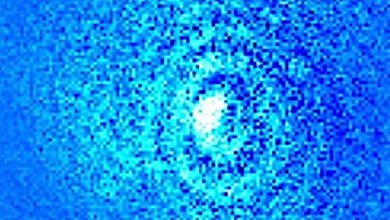
This page is a compilation of a handful of articles that I posted in the early days of Stranger Dimensions, way back in late 2011 and early 2012. They’re woefully outdated, but instead of deleting them, I decided to clean a few things up and add some more details!
The neutrino situation recounted here has come to be known as the 2011 OPERA faster-than-light neutrino anomaly. OPERA was the name of the experiment during which neutrinos were, at first, observed to have traveled faster than the speed of light. As it turned out, this event didn’t quite happen, and in the end scientists working on the project discovered that the irregular data was likely the result of faulty equipment, specifically either the connection between a GPS receiver and the OPERA master clock, or a clock elsewhere that ran “outside its specifications.”
In conclusion, things weren’t working quite right, and neutrinos were not superluminal. At least, not on that day. It happens to the best of us! Still, for posterity’s sake, here are the series of articles I posted on the matter, in order of appearance…
October 4, 2011 – Neutrinos Break the Light Barrier?
So, we’ve apparently broken the unbreakable: The speed of light.
Last month, researchers in Geneva, Switzerland, working in conjunction with CERN, fired some neutrinos 730 km (454 miles) all the way to Gran Sasso, Italy. Those neutrinos arrived at their destination a shocking 60 nanoseconds before they were expected to.
60 nanoseconds sooner than light would have.
However, don’t start drawing up plans for your new time machine just yet.
Quick, get some duct tape!
The majority of physicists are skeptical of these results. There are just too many variables at play here, and even though the scientists working on the OPERA project were no doubt meticulous and very serious about their work, there is always ample room for error.
Even the project leaders themselves are skeptical. In the same breath as announcing their findings, they asked their fellow physicists to attempt to replicate their results and prove them wrong (which is a fairly standard feature of the scientific method).
But even if neutrinos can travel faster than light, what does that mean for us? While it may change a fundamental aspect of how scientists view the universe, would it be as groundbreaking as it seems?
The short answer is yes, it would be groundbreaking.
For so long, we’ve held the steadfast belief that light is a “cosmic constant,” that nothing can travel faster, or else the laws of physics would bend in every which way. For example, according to Einstein’s theories, any object traveling faster than the speed of light would find itself traveling into the past.
The slightly longer answer is that, while these findings, if true, would naturally impact our understanding of the universe, and cause a re-analysis of Einstein’s theories of relativity, that doesn’t mean his theories would become completely obsolete (despite what some may think).
Einstein’s theories have worked great so far, one prime example being our use of GPS navigation and satellites — without relativity, we wouldn’t be able to calculate the very real time dilation effects that occur between those satellites and Earth.
Just because a few neutrinos might toss the greater fate of relativity into the air, that doesn’t mean everything we’ve accomplished using our current physics model will just disappear. So, in general, at least for the time being, our everyday world would remain the same.
However, these results do open up new questions, not the least of which being: If a neutrino could travel faster than the speed of light, could we?
You’re telling me you built a time machine…out of a neutrino?!
Life isn’t so easy. Even with all the weird, garbled nonsense that happens at the quantum level, we here in the more “macro” world at least appear to follow a certain sense of order.
There’s a big difference between us — atomically-composed human beings of mass — and particles of near-zero mass such as neutrinos. Take a human being and accelerate him beyond the speed of light, and while he may end up being the world’s first time traveler, he’ll also probably be able to fit into an empty can of SpaghettiOs.
He’d be a mess. Theoretically.
However, if we could travel beyond the speed of light without accelerating too quickly, then maybe it’d be possible (so, we’d probably be looking at something like a Tipler Cylinder, located in space as a launching point).
Or perhaps we’ll some day be able to manipulate gravitational fields, with which we could control speed without even “moving,” a sort of “gravity assist” through time. That’s all assuming neutrinos can travel faster than light, of course, and that the data isn’t due to erroneous measurements.
At the moment, physicists around the world, including those at Fermilab, are preparing to put these results to task, so we’ll know soon enough whether or not the speed of light remains the speed limit of the universe.
October 19, 2011 – Hey, Neutrinos: What’s The Hurry?
There was a lot of excitement when research coming out of CERN suggested neutrinos could travel faster than the speed of light.
The news was, of course, met with a lot of quirked eyebrows – you don’t just overthrow one of the greatest pillars of physics with a cloud of neutrinos and a difference of 60 nanoseconds. Do you?
Well, no, probably not.
Ronald A.J. van Elburg has published a paper stating that relativity itself may be the reason the neutrino measurements were incorrect. And really, what better to represent Einstein in the case against faster-than-light neutrinos than his own theory? It always seems to jump at the opportunity to prove naysayers wrong.
Here’s the deal: The physicists working on the experiment were using GPS satellites to perform their measurements. However, like I mentioned in an earlier post on this experiment, it’s only because of relativity that we’re able to use GPS satellites at all.
The explanation is a bit complicated, but in general, the satellite’s perspective of the time it took the neutrinos to get from Geneva, Switzerland to Gran Sasso, Italy is different than it would appear here on Earth, at least when comparing the two. It’s possible that when the physicists on Earth received the data from the satellite, they neglected to take that difference into account.
Coincidentally, Elburg states the discrepancy would end up being just about 60.7 nanoseconds, which would account for the neutrinos’ seemingly faster-than-light travel. In other words, his suggestion would destroy the possibility outright.
This isn’t confirmed, of course, and the physicists working on the experiment claim they had accounted for such discrepancies beforehand. But you can be sure scientists won’t rest until we know definitively.
November 18, 2011 – Latest Faster-Than-Light Neutrinos Test Yields Same Results
Neutrinos just don’t seem to be cooperating with our cosmological constant.
Today, physicists working on the OPERA project returned with their latest findings regarding the news that they observed neutrinos arriving to their expected destination 60.7 seconds before light would have. After announcing their original findings in October, there was an understandable amount of skepticism, and in good old scientific fashion, they requested that everyone take a look at their results and run their own experiments. They, too, would have another go at it.
And so they did.
The Italian Institute for Nuclear Physics (INFN) claims to have reached the very same results as their previous tests after running the experiment again. This despite making modifications to the proton beam in order to ensure accurate measurements of the neutrinos’ starting time.
They’re still not completely convinced, though Fernando Ferroni, president of the INFN, said he is “confident” in the results.
The test only accounted for one potential measurement error, however, so further testing needs to be done.
“A measurement so delicate and carrying a profound implication on physics requires an extraordinary level of scrutiny,” Ferroni said, adding that, “A final word can only be said by analogous measurements performed elsewhere in the world.”
Other physicists agree, including those at Fermilab, who still question the OPERA project’s accuracy of their time measurements. They may still need to take into account the time differences between CERN and the GPS used to make them.
February 25, 2012 – Was A Faulty Cable Responsible For “Faster-Than-Light” Neutrinos?
They could have changed the world as we knew it. Overturned one hundred years of accepted physics. Shattered one of the fundamental pillars of our understanding of the universe.
Instead, it may have all come down to “bad wiring.”
I posted about this a few times last year: Back in September 2011, scientists working on the Opera project at CERN measured neutrinos arriving at their projected destination a full 60.7 nanoseconds sooner than light would have. The implications of this were extraordinary, so they announced their findings and called for other scientists to duplicate the experiment. The original project scientists did so, as well, and reportedly came up with the same result.
All throughout this muddled series of events, many wondered if it wasn’t just a miscalculation. Perhaps they’d forgotten to take into account the time dilation effects between Earth and satellites, for example. Now, we come to find out that the incredible findings may have been caused by problems with a “timing gear” and an “optical fiber connection,” according to BBC News.
FTL Neutrinos, Part II
Unfortunately, this could go either way, potentially leading to even more confusion.
Depending on which problem affected the results — the “timing gear” or the “optical fiber connection” — the neutrinos could end up either being slower than the speed of light, or even faster than originally measured.
At any rate, efforts to replicate the experiment and ultimately confirm or deny the results are still in progress, and I’m sure we’ll hear about it every step of the way. Such is the scientific process.
I will say this, though: Before you attempt to overturn a fundamental theory at the foundations of modern physics, please make sure everything’s plugged in correctly. It really does help.
March 19, 2012 – Neutrinos! Stop, In The Name Of The…Laws Of Physics!
I suppose I should write something about the outcome of that whole faster-than-light neutrino situation, given that I’ve written so much about them already. But I’ll make this one quick.
On Friday, scientists at CERN announced the results of their latest neutrino speed test, called the Icarus experiment. The final answer? Neutrinos do not travel faster than the speed of light. Einstein wins again.
Since the original announcement back in October September, it was always very, very likely that the results were due to faulty measurements or some other miscalculation. Even a few months ago, the scientists revealed that faulty wiring may have been the culprit. Now, thanks to the Icarus team, who reattempted OPERA’s experiment, the story finally seems to be coming to an end.
According to Sandro Centro, co-spokesman of the Icarus team, “I think they were a little bit in a hurry to publish something that was astonishing, and at the end of the day it was a wrong measurement.”
Of course, I’d always held out hope; the thought of shattering one of the fundamental pillars of modern physics was exciting. But science is science, and we have to move on. We still have the Higgs Boson to look forward to!






